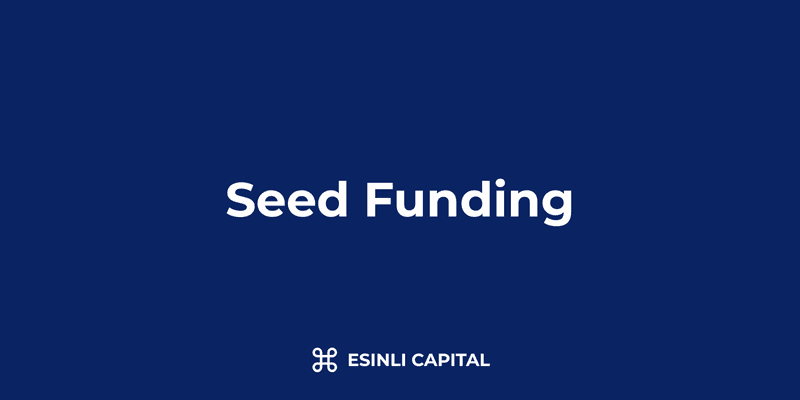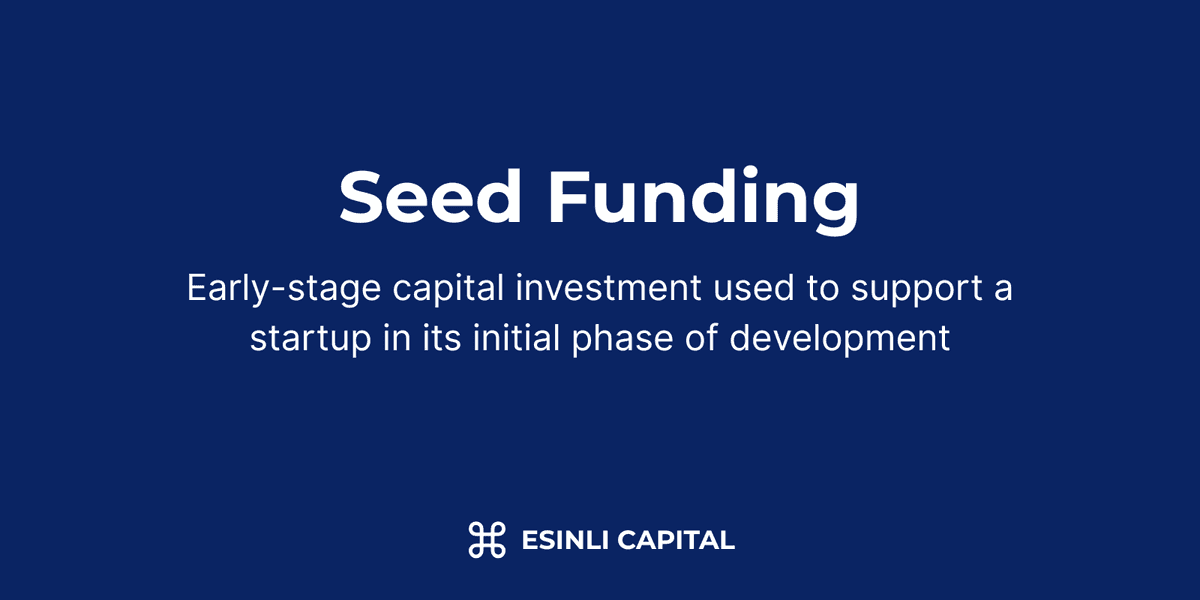In This Article
- What Is Seed Funding?
- Why Is Seed Funding Important for Startups?
- Seed Funding vs. Other Funding Stages
- How to Secure Seed Funding for Your Startup
- Common Seed Funding Challenges and How to Overcome Them
- Seed Funding: Definition, Structure and Investment Terms
- The Evolution of Seed Funding
- Conclusion: Building a Foundation for Growth
- What Is Seed Funding?
- Why Is Seed Funding Important for Startups?
- Seed Funding vs. Other Funding Stages
- How to Secure Seed Funding for Your Startup
- Common Seed Funding Challenges and How to Overcome Them
- Seed Funding: Definition, Structure and Investment Terms
- The Evolution of Seed Funding
- Conclusion: Building a Foundation for Growth

Seed Funding: Definition, Process & Typical Terms
KEY TAKEAWAYS
- Seed funding is the first official equity funding stage, typically ranging from $50,000 to $2 million, used to finance a startup's initial market research, product development, and team building.
- The seed round funding process generally takes 3-6 months and involves pitching to angel investors, early-stage VCs, family offices, and increasingly, specialized seed funds.
- Average seed valuations in 2025 range from $3-8 million pre-money, with investors typically acquiring 10-25% of equity in exchange for their capital.
- Successful seed fundraising requires a compelling vision, initial traction metrics, a clear path to product-market fit, and a credible founding team with complementary skills.
- Most seed rounds are structured as convertible notes, SAFE (Simple Agreement for Future Equity) agreements, or priced equity rounds with standard term sheets.
What Is Seed Funding?
Seed funding is the first official equity funding stage that helps a startup grow from an initial idea to a business with a functional product and market presence. This early-stage capital infusion provides entrepreneurs with the resources necessary to transform their concepts into tangible business operations—covering expenses for preliminary market research, product development, hiring key team members, and establishing initial traction.
Unlike later funding rounds, seed funding occurs when a startup is in its formative stages, often before generating significant revenue or achieving product-market fit. The capital raised during this phase is metaphorically the "seed" that allows the business to take root and grow toward subsequent funding stages.
The typical seed funding amount ranges from $50,000 to $2 million, though this can vary widely based on industry, geography, market conditions, and the company's specific needs. This investment is typically exchanged for equity or convertible instruments that will later convert to equity.
How Seed Funding Works
Seed funding works as a critical bridge between a startup's earliest self-funded days (often called bootstrapping or pre-seed) and its first significant institutional funding round (Series A). The process involves several key components:
Sources of Seed Capital
Seed funding typically comes from a variety of sources, each with different investment approaches and expectations:
- Angel investors: High-net-worth individuals who invest their personal capital, often bringing industry expertise and connections along with their money.
- Early-stage venture capital firms: Smaller VC firms or venture funds that specifically focus on seed-stage companies.
- Family offices: Private wealth management advisory firms that serve ultra-high-net-worth individuals or families.
- Seed funds: Specialized investment vehicles designed specifically to deploy capital at the seed stage.
- Startup accelerators: Programs like Y Combinator, Techstars, or 500 Startups that provide funding (usually $100,000-$150,000) along with mentorship and resources in exchange for equity.
- Crowdfunding platforms: Sites like Republic, SeedInvest, or Wefunder that allow startups to raise capital from numerous smaller investors.
- Strategic investors: Established companies that invest in startups relevant to their industry or technology focus.
The Seed Funding Process
The typical seed funding process follows these steps:
- Preparation: The startup develops a compelling pitch deck, financial projections, and a clear articulation of the problem they're solving.
- Investor targeting: Entrepreneurs identify and research potential investors who fund companies in their industry and stage.
- Networking and introductions: Founders leverage their network to secure warm introductions to target investors.
- Initial meetings: First meetings focus on introducing the company vision, team, and opportunity.
- Due diligence: Interested investors will conduct research on the market, product, team, and competitive landscape.
- Term sheet negotiations: If an investor decides to proceed, they'll issue a term sheet outlining the investment conditions.
- Legal documentation: After agreeing on terms, lawyers draft and review formal investment agreements.
- Closing: Funds are transferred, and the investment is finalized.
The entire process typically takes 3-6 months, though this timeline can vary significantly based on market conditions and investor interest.
Typical Seed Funding Terms
Seed investments are typically structured in one of three ways:
- Convertible notes: Debt instruments that convert to equity at a future funding round, usually with a discount and/or valuation cap.
- SAFE agreements (Simple Agreement for Future Equity): Created by Y Combinator, these are simplified convertible instruments without debt components or maturity dates.
- Priced equity rounds: Traditional equity investments with a fixed valuation, resulting in the investor owning a specific percentage of the company.
Common terms in seed funding agreements include:
- Valuation: In 2025, average seed-stage pre-money valuations typically range from $3-8 million, though this varies by industry and geography.
- Equity stake: Seed investors typically acquire 10-25% of the company.
- Board seats: Some seed investors may request board representation or observer rights.
- Pro-rata rights: The right for investors to maintain their ownership percentage in future funding rounds.
- Founder vesting: Schedules (typically four years with a one-year cliff) that determine when founders earn their equity.
- Investor protections: Provisions like anti-dilution protection, liquidation preferences, and information rights.
Why Is Seed Funding Important for Startups?
Seed funding serves as a critical lifeline for early-stage companies, providing numerous benefits that extend beyond mere capital:
Financial Runway and Resource Access
The most obvious advantage of seed funding is providing the financial runway necessary to develop a product without immediate revenue pressure. This capital allows startups to:
- Hire key technical and business talent
- Develop and iterate on product prototypes
- Invest in essential tools and infrastructure
- Conduct market research and customer discovery
- Cover operational expenses while building toward revenue
Validation and Credibility
Securing seed funding serves as a form of external validation for a startup's concept and team. When experienced investors put their capital behind a company, it signals to the market that:
- The business idea has been vetted by professionals who believe in its potential
- The founding team has demonstrated capabilities that inspire confidence
- The market opportunity is significant enough to warrant investment
This validation can help attract talent, partners, and customers who might otherwise be hesitant to engage with an unproven startup.
Expert Guidance and Network Access
Beyond capital, seed investors typically provide valuable guidance and connections:
- Strategic advice: Experienced investors often have insights into business model refinement, go-to-market strategies, and potential pitfalls.
- Industry connections: Investors can make introductions to potential customers, partners, and future investors.
- Operational support: Many seed funds and angels provide hands-on assistance with recruiting, financial planning, and operational challenges.
Path to Follow-on Funding
A successful seed round positions a startup for future funding:
- It establishes a valuation baseline for the company
- It creates relationships with investors who may participate in future rounds
- It provides the resources to achieve milestones necessary for Series A fundraising
Seed Funding vs. Other Funding Stages
Understanding how seed funding compares to other startup financing stages helps founders navigate the funding landscape:
| Aspect | Pre-Seed | Seed | Series A | Series B |
|---|---|---|---|---|
| Typical amount | $25K-$500K | $50K-$2M | $2M-$15M | $15M-$50M |
| Company stage | Concept/MVP | Working product, early traction | Product-market fit, revenue growth | Scaling, established business model |
| Primary investors | Friends/family, angels, accelerators | Angels, seed funds, early VCs | Institutional VCs | Larger VC firms, growth equity |
| Main use of funds | MVP development, customer discovery | Product development, initial traction | Market expansion, team growth | Scaling operations, expansion |
| Expected milestones | MVP, initial user feedback | Product-market fit, early revenue | Significant revenue growth, unit economics | Profitability path, major market share |
| Typical valuation (2025) | $1M-$3M | $3M-$8M | $10M-$50M | $50M-$250M+ |
Pre-Seed vs. Seed Funding
Pre-seed funding is the earliest stage of investment, often coming before a formal seed round:
- Pre-seed typically funds the development of a minimum viable product (MVP) and initial customer discovery.
- Seed funding generally assumes some form of MVP exists and focuses on product refinement and initial market traction.
The lines between these stages have blurred in recent years, with some companies raising larger "pre-seed" rounds that resemble traditional seed rounds.
Seed Funding vs. Series A
The primary distinction between seed and Series A funding relates to business maturity:
- Seed is about potential and early validation—funding product development and initial market entry.
- Series A requires demonstrated traction—typically meaningful revenue growth, customer acquisition metrics, or user engagement statistics.
Series A rounds also involve more structured due diligence, formalized governance, and higher investor expectations for reporting and performance metrics.
How to Secure Seed Funding for Your Startup
Securing seed funding requires strategic preparation and execution. Here's a comprehensive approach to maximize your chances:
1. Prepare Your Fundraising Materials
Before approaching investors, ensure you have compelling materials that clearly communicate your vision and opportunity:
- Pitch deck: A concise 10-15 slide presentation outlining your problem, solution, market, business model, team, traction, and funding needs.
- Financial model: Realistic projections showing how you'll use the funds and your expected growth trajectory.
- Executive summary: A 1-2 page document summarizing your business for initial investor screening.
- Product demo: A functional demonstration of your product or a well-designed prototype.
- Technical documentation: For deep tech startups, materials explaining your technological innovation and IP position.
2. Understand What Seed Investors Look For
In 2025, seed investors typically evaluate startups based on:
- Team strength: The founding team's expertise, track record, complementary skills, and ability to execute.
- Market opportunity: The size, growth rate, and accessibility of the target market.
- Product differentiation: How the solution stands out from alternatives and addresses real customer pain points.
- Initial traction: Early evidence of product-market fit through user metrics, pilot customers, or revenue.
- Business model clarity: A clear path to monetization and scalable customer acquisition.
- Capital efficiency: How effectively the company can deploy investment to reach meaningful milestones.
- Exit potential: Realistic paths to acquisition or further funding rounds.
3. Build Investor Relationships Early
The most successful seed fundraising efforts begin long before the formal process:
- Establish connections: Network at industry events, join startup communities, and leverage alumni networks.
- Share progress updates: Keep potential investors informed about your milestones and learnings.
- Seek advice before money: Build relationships by asking for specific advice rather than immediately pitching for investment.
- Research investor fit: Target investors with experience in your sector and stage who can add value beyond capital.
4. Craft a Compelling Fundraising Narrative
Investors fund stories they believe in. Your narrative should:
- Clearly articulate the problem and why it matters
- Explain your unique insight or approach
- Demonstrate why your team is uniquely positioned to succeed
- Present early traction as validation of your hypotheses
- Paint a vision of what success looks like with their investment
5. Execute an Efficient Fundraising Process
Once you begin formal fundraising:
- Create momentum: Target multiple investors simultaneously to create a sense of urgency.
- Be prepared for due diligence: Organize your corporate, financial, and technical documentation.
- Follow up strategically: Maintain communication without being pushy.
- Know your numbers: Be ready to discuss your metrics, unit economics, and capital needs in detail.
- Prepare for objections: Anticipate and practice responses to common investor concerns.
6. Negotiate Fair Terms
When receiving term sheets:
- Understand the implications: Consult with experienced advisors or lawyers about how terms might impact your future.
- Focus on the important terms: Valuation matters, but terms like liquidation preferences, board control, and vesting schedules can be equally important.
- Consider the investor relationship: Sometimes better terms from a less valuable partner aren't worth the trade-off.
Common Seed Funding Challenges and How to Overcome Them
Despite its critical importance, securing seed funding comes with significant challenges. Here's how to navigate the most common obstacles:
Market Timing and Conditions
Challenge: Fundraising difficulty varies dramatically based on macroeconomic factors and investment cycles.
Solution:
- Maintain at least 12 months of runway whenever possible to avoid raising during downturns
- Adjust your valuation expectations based on current market conditions
- Consider alternative funding sources during tight markets (revenue financing, grants, etc.)
The Cold Start Problem
Challenge: First-time founders often struggle to get initial investor meetings without a track record.
Solution:
- Leverage accelerator programs that provide built-in investor access
- Build relationships with angel investors in your personal and professional networks
- Create social proof through advisors with strong investor connections
- Demonstrate exceptional domain expertise and early execution
Limited Traction
Challenge: Early-stage investors increasingly expect some level of traction, creating a chicken-and-egg problem.
Solution:
- Focus on creative, low-cost ways to validate your assumptions
- Develop case studies or pilots with beta customers
- Highlight leading indicators like signed LOIs, waitlists, or user engagement
- Be transparent about your learnings and hypothesis validation
Valuation Disputes
Challenge: Founders and investors often have different perspectives on appropriate valuations.
Solution:
- Research comparable companies at similar stages
- Consider convertible instruments that delay valuation decisions
- Focus discussions on milestone-based value creation
- Be prepared to justify your valuation with metrics and progress
Investor Alignment
Challenge: Bringing in investors with misaligned expectations or vision can create future conflicts.
Solution:
- Clearly articulate your vision and business philosophy upfront
- Ask investors about their expectations for future rounds and exits
- Check references from other founders in the investor's portfolio
- Prioritize investors who understand your specific market dynamics
Seed Funding: Definition, Structure and Investment Terms
Seed funding has evolved significantly over the past decade, with increasingly standardized structures and terms. Understanding these components helps founders negotiate more effectively and avoid potential pitfalls.
Funding Instruments and Their Implications
The three primary seed funding structures each have distinct advantages and considerations:
Convertible Notes
Structure: Debt instruments that convert to equity at a qualified financing event.
Key terms:
- Interest rate: Typically 4-8% annually
- Maturity date: Usually 18-24 months
- Conversion discount: 15-25% off the next round's price
- Valuation cap: Maximum effective valuation for conversion purposes
Advantages:
- Postpones formal valuation discussions
- Simpler and less expensive documentation
- Faster to close than priced rounds
Considerations:
- Interest accrual increases investor ownership
- Maturity dates create pressure for next rounds
- Multiple notes with different terms can complicate cap tables
SAFE Agreements
Structure: Contractual rights to future equity without debt components.
Key terms:
- Valuation cap: Maximum effective valuation for conversion
- Discount rate: Reduction from future round pricing (sometimes uncapped)
- Most Favored Nation (MFN) provision: Right to adopt more favorable terms given to later investors
- Pro-rata rights: Option to maintain ownership percentage in future rounds
Advantages:
- No interest or maturity dates
- Standardized documentation reduces legal costs
- More founder-friendly than convertible notes
Considerations:
- Post-money SAFEs (Y Combinator's current standard) can result in more dilution than founders expect
- Multiple SAFE rounds can significantly complicate capitalization
- Some investors prefer the protections of priced rounds
Priced Equity Rounds
Structure: Direct purchase of preferred equity at an agreed valuation.
Key terms:
- Pre-money valuation: Company value before investment
- Liquidation preference: Investor right to receive funds before common shareholders (typically 1x)
- Participation rights: Whether investors can "double-dip" after receiving their preference
- Anti-dilution protection: Protection against future down rounds
- Board composition: Who controls board seats and voting
Advantages:
- Clear ownership and rights structure
- Greater certainty for all parties
- Establishes proper corporate governance
Considerations:
- Higher legal costs ($15,000-$30,000)
- More complex negotiation process
- Longer time to close (typically 4-8 weeks)
Current Seed Funding Metrics (2025)
Seed funding metrics vary by industry, geography, and company stage, but current benchmarks include:
- Average seed round size: $1.1 million
- Pre-money valuation range: $3-8 million
- Typical equity sold: 15-25%
- Average time from founding to seed: 12-18 months
- Expected runway from seed: 12-24 months
- Median time to Series A: 18-24 months after seed
Due Diligence Requirements
Seed investors' due diligence expectations have increased in recent years. Be prepared to provide:
- Corporate documents: Certificate of incorporation, bylaws, capitalization table
- IP documentation: Patent applications, trademark registrations, assignment agreements
- Financial information: Historical financials, projections, burn rate calculation
- Product metrics: User engagement, retention, conversion funnels
- Technical assessment: Architecture documentation, security protocols, development roadmap
- Team background: Founder history, key employee agreements, option plans
- Market analysis: Competitive landscape, entry barriers, market sizing
Red Flags That Deter Seed Investors
Avoiding these common red flags can significantly improve your fundraising prospects:
- Founder conflicts: Signs of disagreement or misalignment between co-founders
- Unrealistic projections: Hockey-stick growth forecasts without credible assumptions
- Excessive valuation expectations: Asking for valuations far above market comparables
- Scattered focus: Pursuing too many opportunities simultaneously
- Limited domain expertise: Founding teams without relevant industry experience
- Unwillingness to listen: Defensive responses to investor questions or feedback
- Regulatory uncertainty: Unclear pathways through significant regulatory hurdles
- Opaque communication: Vague answers about business fundamentals or challenges
The Evolution of Seed Funding
The seed funding landscape continues to evolve rapidly. Understanding these trends helps founders navigate the current environment more effectively.
Historical Context and Recent Changes
Seed funding has undergone significant transformation over the past two decades:
Early 2000s:
- Typical seed rounds were $250,000-$500,000
- Friends, family, and individual angels dominated
- Limited standardization of terms and documents
- Primarily available in major tech hubs
2010-2015:
- Rise of accelerator programs democratized early funding
- Convertible notes became standard instruments
- Angel syndicates emerged through platforms like AngelList
- Seed sizes increased to $500,000-$1 million
2016-2020:
- Institutional seed funds proliferated
- Y Combinator introduced and popularized SAFEs
- "Pre-seed" emerged as a distinct funding stage
- Geographic diversification of seed investing began
2021-2025:
- Seed round sizes expanded to $1-2 million average
- Increased expectations for traction and metrics
- Rise of specialized seed funds focused on specific sectors
- Greater focus on founder diversity and inclusion
- Remote fundraising processes became normalized
- Extended "seed-to-Series A" timelines (18-24 months)
Current Market Trends (2025)
Today's seed funding environment is characterized by:
- Bifurcation of the market: Elite founders can raise quickly at premium valuations while others face more scrutiny
- Sector-specific dynamics: Certain industries (AI, climate tech, healthcare) command higher valuations and larger rounds
- Investor specialization: More seed investors focus on specific verticals rather than generalist approaches
- Data-driven decision making: Investors leverage data analytics and scoring systems for deal evaluation
- Extended pre-Series A runways: Companies raising multiple seed rounds before Series A
- Focus on capital efficiency: Renewed emphasis on reasonable burn rates and clear paths to profitability
- Alternative funding options: Growth of revenue-based financing, crowdfunding, and specialized venture debt
The Future of Seed Funding
Several emerging trends will likely shape seed funding in the coming years:
- Algorithmic investing: AI-powered systems supplementing human decision-making for initial screening
- Tokenization and blockchain infrastructure: New investment structures leveraging digital assets
- Globalization of seed capital: Increasing investment in emerging markets
- ESG integration: Greater emphasis on environmental, social, and governance factors
- Community-based investing: New models connecting founders directly with user-investors
- Vertical-specific funding structures: Custom investment instruments designed for different business models
Conclusion: Building a Foundation for Growth
Seed funding represents more than just capital—it's the foundation upon which successful companies are built. By securing the right investors with fair terms, startups gain the resources, guidance, and runway needed to transform early promise into significant traction.
The most successful seed fundraising outcomes result from thorough preparation, strategic relationship building, and clear communication of a compelling vision. While the process can be challenging, particularly for first-time founders, understanding investor expectations and current market dynamics significantly improves the likelihood of success.
For founders navigating this crucial stage, remember that the quality of your seed investors often matters more than the valuation. Selecting partners who provide relevant expertise, valuable connections, and aligned expectations creates a stronger foundation for future growth than optimizing purely for dilution or terms.
As you embark on your seed funding journey, focus on building sustainable value rather than simply raising capital. The most successful companies use seed funding as a tool to systematically reduce risk, validate assumptions, and position themselves for long-term success—creating the foundation for a company that can thrive through multiple stages of growth.



